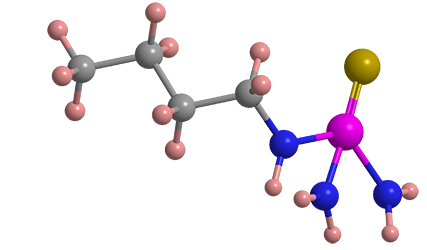What molecule am I?


N-(n-Butyl)thiophosphoric triamide (NBPT) is a specialty fertilizer additive. It was first reported in 1956 by Margot Goehring*1 and Kurt Niedenzu at the University of Heidelberg (West Germany). The authors described processes for making phosphoramide2 [PO(NH2)3], as well as alkylated amides of orthophosphoric acid and thiophosphoric acid, including NBPT.
NBPT inhibits the enzyme urease, a widespread component of soil microorganisms. Urease converts urea, a commonly used nitrogen fertilizer, to ammonia, which can volatilize before it is absorbed by crops. NBPT is called an enhanced efficiency nitrogen fertilizer (EENF) because it fosters improved intake of nitrogen, potentially allowing the grower to decrease the amount of urea applied to a crop.
NBPT has been used successfully in agriculture for more than 20 years. A 2018 review by Heitor Cantarella and coauthors at the Agronomic Institute of Campinas and other Brazilian institutions described the compound’s effectiveness but suggested that formulations be improved to lengthen the period of urease inhibition and to increase shelf life.
In 2019, as if on cue from Cantarella et al., Ahmed A. Lasisi, Olalekan O. Akinremi*, and Darshani Kumaragamage at the University of Manitoba (Winnipeg, Canada) and the University of Winnipeg reported an NBPT formulation that lowered the required concentration of the EENF in urea and urea–ammonium nitrate fertilizers without decreasing urease-inhibition performance. The formulation included a new polymer that uniformly covers NBPT-enhanced urea fertilizers and extends the usability of the product at low temperatures.
1. Goehring was the first female rector at a West German university.
2. CAS Reg. No. 13597-72-3.
N-(n-Butyl)thiophosphoric triamide hazard information*
| Hazard class** | GHS code and hazard statement | |
|---|---|---|
| Acute toxicity, oral, category 4 | H302—Harmful is swallowed | |
| Skin corrosion/irritation, category 2 | H315—Causes skin irritation | |
| Serious eye damage/eye irritation, category 1 | H318—Causes serious eye damage | |
| Specific target organ toxicity, single exposure, respiratory tract irritation, category 3 | H335—May cause respiratory irritation | |
| Specific target organ toxicity, single exposure, narcotic effects, category 3 | H336—May cause drowsiness or dizziness | |
| Reproductive toxicity, category 2 | H361—Suspected of damaging fertility or the unborn child | |
*Compilation of multiple safety data sheets; in each class, the most hazardous category is shown.
**Globally Harmonized System (GHS) of Classification and Labeling of Chemicals. Explanation of pictograms.
Molecules from the journals
Gallium phosphide1 (GaP) is an inorganic compound that is a useful semiconductor in optical systems and light-emitting diodes. It is an orange solid with a melting point of 1457 °C.
GaP was first described in 1952 by Heinrich Welker at Siemens-Schuckert (Erlangen, West Germany); he compared the semiconductor properties of binary compounds of group 13 and group 15 elements with those made solely from group 14 elements.2 Two years later, O. G. Folberth und F. Oswald, also at Siemens-Schuckert, elaborated on the semiconductor properties of GaP.
More recently, GaP has shown value as a photocatalyst. Earlier this month, Frank E. Osterloh and co-workers at the University of California, Davis, reported that GaP particles, together with a nickel phosphide3 cocatalyst, promoted the evolution of hydrogen from water under 525-nm irradiation with a record 14.8% apparent quantum efficiency.
(+)-Archangiumide4 is a macrocyclic natural product that contains an allene (C=C=C) moiety in its ring, only the second such compound to be discovered. This finding was reported in 2021 by Yue-Zhong Li, Changsheng Wu, and colleagues at Shandong University (Qingdao, China), who described the isolation of the 19-member macrolide from the myxobacterium Archangium violaceum.
This past January, Jack L. Sutro and Alois Fürstner* at the Max Planck Institute for Coal Research (Mülheim an der Ruhr, Germany) reported the total synthesis of (+)-archangiumide. The allenic group was formed in the last step of the 13-step synthetic sequence.
1. CAS Reg. No. 12063-98-8.
2. At the time, the groups were known as 3 through 5.
3. CAS Reg. No. 12035-64-2.
4. As of this writing, a CAS Reg. No. has not been assigned to this molecule.
Molecules from the Journals
MOTW briefly describes noteworthy molecules that appeared in recent ACS journal articles. See this week's
edition below.
This molecule was suggested by a reader. We present almost all of the molecules suggested by our readers. If you have a molecule you would like us to consider, please send us a message. And thank you for your interest in Molecule of the Week! —Ed.
N-(n-Butyl)thiophosphoric triamide fast facts
| CAS Reg. No. | 94317-64-3 |
| CA Index Name | Phosphorothioic triamide, N-butyl- |
| Empirical formula | C4H14N3PS |
| Molar mass | 167.21 g/mol |
| Appearance | White powder |
| Melting point | 56–58 °C |
| Water solubility | 4.3 g/L (25 °C) |

Learn more about this molecule from CAS, the most authoritative and comprehensive source for chemical information.
Molecule of the Week needs your suggestions!
If your favorite molecule is not in our archive, please send us a message. The molecule can be notable for its current or historical importance or for any quirky reason. Thank you!
Stay Ahead of the Chemistry Curve
Learn how ACS can help you stay ahead in the world of chemistry.

